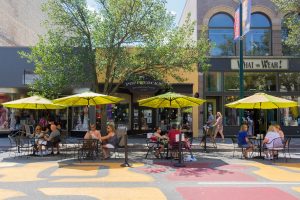With the arrival of summer, Michiganders are preparing to spend more time together in the great outdoors. The closure of gyms and wellness event cancellations due to the COVID-19 pandemic has also given rise to more people using recreation amenities. As a result, parks, trails, downtowns, and neighborhoods have seen an increase in foot and multiple forms of nonmotorized traffic.
With this rise, people are recognizing that many sidewalks are too narrow to maintain social distancing. There is a new movement across many Michigan communities to encourage local leaders to limit motor vehicle traffic on low-volume streets to create more space for walking, biking, and rolling. The Federal Highway Administration has also jumped on board by allowing temporary closures of parking lanes in federally owned downtown corridors. This allows more space for restaurants and stores to do business and observe social distancing guidelines.
“Municipalities are getting creative”, shares Michigan Fitness Foundation President and CEO Amy Ghannam. “Some are constructing temporary one-way closures and others are closing parking lanes to create wider space for sidewalks and pedestrians.”

If you are looking to do the same in your community, there are a few things to know. Michigan Fitness Foundation’s Safe Routes to School (SRTS) program staff have compiled the following information for Michigan communities looking for solutions.
Campaigns to urge local leaders to create space on streets are best accomplished with a thoughtful, informed approach with an understanding of ordinances and knowledge of who owns the roadway. For example, to open a locally owned road for temporary pedestrian access, the following approach is recommended;
- Work with their local governing body to legally close the roadway to car traffic via a resolution;
- Engage local property owners impacted by the project; and
- Work with local officials to conduct the closure.
To close a federally owned road, the local municipality would need to apply for partial route closure permit to MDOT Transportation Service Center (TSC) Office, and ensure the following is met;
- The municipality will need to have a governmental resolution on file with MDOT;
- Submit an MDOT form UP-67 (Request for Route Closure); and
- Apply for the Permit Online.
Just as with a locally owned road, the responsibility for law enforcement, notification to property owners, ensuring appropriate ADA provisions, and vehicular detours fall to the municipality or Local Road Agency. For additional information on this topic, visit the Safe Routes Partnership.
The National Association of City Transportation Officials (NACTO) has been compiling information and resources actions cities are taking in response to the pandemic. Their Streets for Pandemic Response and Recovery compiles emerging practices from around the world, how to use streets for recovery and response and includes implementation resources for cities and their partners.
Photo Credit: Downtown Traverse City Association
